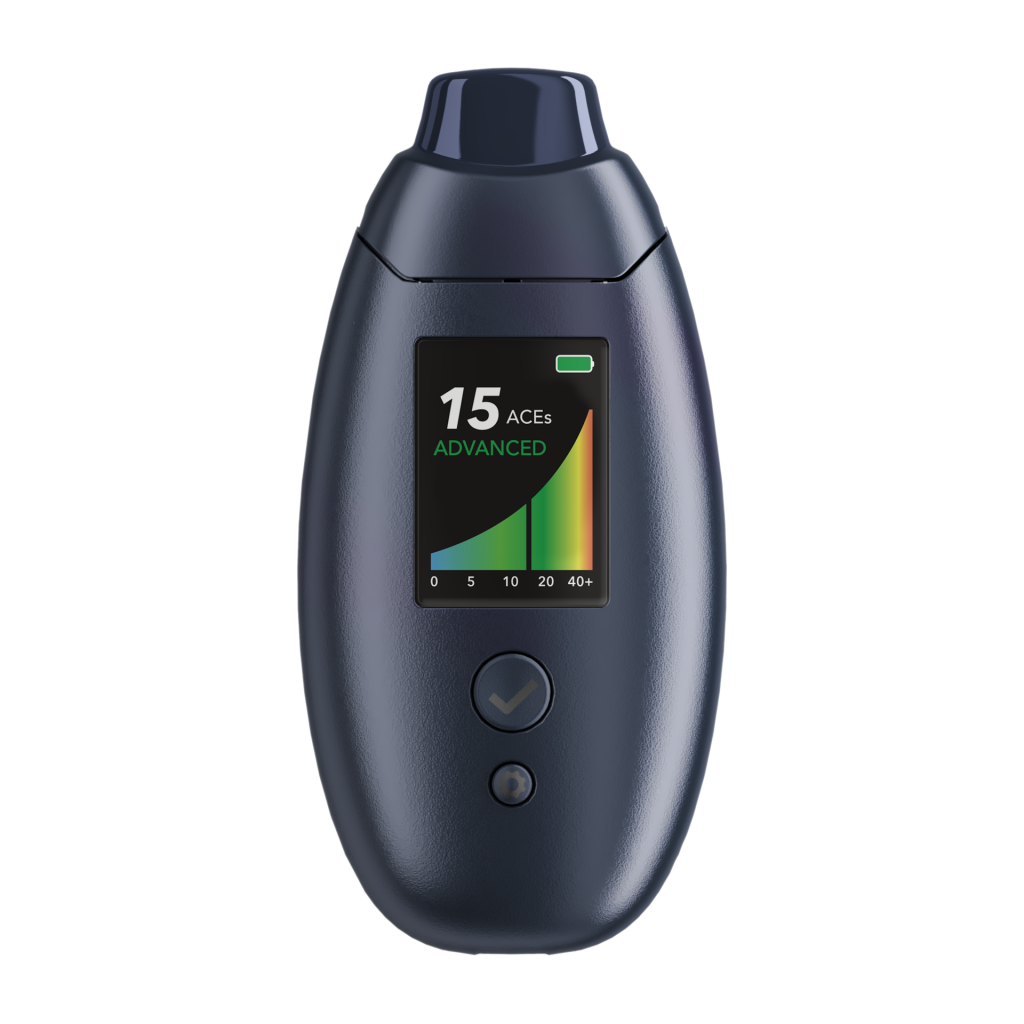These days, you can track everything. Your sleep, your steps, your calories – anything you can think of. But one of the most important aspects of health that is often overlooked when discussing tracking – is fat burning. That’s right, hardly anyone mentions tracking fat burning, even though it is typically the main goal of going on any diet. Sure, weight loss overall is heavily tracked – but not fat burning. Part of the problem is that there hasn’t been an easy, accurate way to track your fat burning. Until now.

To help solve this problem, we invented the first and only clinically-backed ketone breath monitor accurate enough to replace invasive blood measurements. By simply breathing in our device, you will have a reliable measurement of your current ketone levels in seconds. You will know your fat burning levels instantly. No more urine strips, no more pricking your finger – just a fast, easy and reliable breath test. You can bring our device with you to the office, take it to the gym – you can truly check your ketones anywhere. Unlike previous devices, which were often poorly made, unreliable, and not backed by clinical research – our ketone breath monitor is patented. This means no other device is legally allowed to use our exclusive technology. Whether you are brand new to keto and want a convenient and reliable way to check your ketone levels, or you’re an elite level biohacker – Biosense is the perfect way to measure your ketones.
You don’t need to worry about continually buying strips, continually pricking your finger – we have all you need, in just one device. One of our favorite features is the personalized insights you get with the device. Every time you measure, your results are graphed and stored, so you can easily track your progress and share with clinicians, coaches, or friends.. Until now, there has not been an easy and convenient way to check your ketone levels – which has made many people give up on keto entirely. But that outcome is no longer necessary, as we’ve made a device that does all the work for you. Just simply take one breath into the device, and within seconds you’ll know your ketone level. Whether your goal is to burn fat, lose weight, improve your blood sugar – we have the answer.
Why Do People Follow the Keto Diet?
Let’s back up a little bit – why is the keto diet so great for fat burning? And why has the keto approach completely taken over the health and fitness world? Keto has an increasingly large following for two reasons. The first – keto works. It leads to weight loss, fat loss, reduced cravings, and improvements in nearly every biomarker of health. The second – keto makes you feel great. Talk to anyone currently on the keto diet – they have increased mental functioning, less inflammation and are leaner, happier and more focused. When you’re not constantly falling into random energy slumps, you aren’t always craving sugar, and you are losing weight – life is just a little bit sweeter.
All of these lifestyle benefits are great, and also help lead to weight loss. However, keto is not magic. It takes daily, consistent work. In fact, if you are not used to tracking any of your food intake, it can be downright intimidating to start tracking all the necessary information. Just as you need to track your daily work progress on an important project, you need to track your body’s progress when you want to improve it. You need to know the exact numbers of what you are taking in, where you started, and if you are hitting your daily goals. In simpler terms – you need data. By the end of this article, you will have all the right tools necessary to succeed with the ketogenic diet.
How Does the Keto Diet Lead To Weight Loss?
Before we dive too deep into specifics, we need to understand exactly why the keto diet works. Unlike the standard American diet, which is very high in carbohydrates, the ketogenic diet contains hardly any carbs. This lack of carbohydrates leads directly to a state called nutritional ketosis. This metabolic state is recognized when your body shifts into turning stored fatty acids into ketones, which are then used as your body’s main energy source.
Your body actually has reserves of glucose (called glycogen stores). This is commonly seen as excess body fat. When you cut out carbs, your body starts to shift into using this stored fat. Because you are not taking in any sugar, keto also leads to lower and more stabilized blood sugar levels. As you may have been able to deduce, lowered and stabilized blood sugar levels, combined with a newfound ability to tap into stored fat – leads to weight loss.
Interestingly, there are far more benefits to keto beyond just mere weight and fat loss. The diet was actually originally devised as a way to treat epilepsy, and other scientific research has shown that the keto diet has potential benefits for those with neurological conditions. Additionally positive research has been done with keto and those with blood sugar issues, as well as with those suffering from heart disease. But the real secret to a successful ketogenic diet is that when your body burns fat, it starts producing large amounts of ketones. And not to be too obvious, but without ketones, you’re simply not in ketosis. The top goal for keto dieters then, is to maximize ketone production.
What Are Ketones? And Do They Help With Fat Burning?
But before we maximize ketone production, we need to understand exactly what ketones are. During the metabolic shift away from carbohydrates, your body turns fatty acid into ketones. In this case, your body essentially responds to a depletion of carbohydrates, by quite literally making a new form of fuel. These ketones are produced by your liver, and they are composed of fat (hence why the keto diet is usually referred to as a ‘fat burning’ approach). While ketone production is greatly increased during a ketogenic diet, the truth is that ketones are nearly always floating around your system.
The process of stored fat turning into energy, is known as beta-oxidation. There used to be confusion around ketosis and a much different (and highly dangerous) process called ‘metabolic ketoacidosis’. But the truth is that these two states have very little in common. During the process of ketosis, which is very safe, any excess ketones will be eliminated via your breath or urine. Interestingly, there is not just one type of ketone body but rather three. There’s acetone, BHB (beta-hydroxybutyric acid), and AcAc (acetoacetate). Of these, BHB is not technically a ketone, due to its structure. However, for our intents and purposes, BHB is included in nearly every discussion of ketogenic diets.
Both AcAc and BHB help to transport energy from your liver, to the other tissues inside your body. AcAc is the first ketone created, and from there, BHB is formed. Acetone is made as a byproduct of AcAc, but it plays the least important role in the metabolic process of ketosis. Acetone is also notable for being the main reason behind keto breath, which is that slightly fruity smell, that sometimes accompanies a keto dieter’s outward breath. Scientists are not entirely sure why we have the ability to go into ketosis, but surmise that we have it because our ancestors needed an alternative fuel when food was scarce for long periods of time. This actually makes perfect sense, as otherwise we would have starved fairly quickly, and possessed no other way to produce energy. In fact, before agriculture, it’s estimated that most of the human diet was very low carb. Back then, higher carbohydrate foods were largely unavailable.

But Isn’t All That Fat Bad For You?
For decades it was accepted that dietary fat was one of the worst things you could consume. This led to the low-fat craze of the 1990s. What most people don’t know is that at exactly the same time as the rise of low fat diets came a near-identical rise in rates of obesity. In fact, the world has never struggled as much with weight gain as it has today. Unfortunately, the American diet is largely to blame. As scientific studies have shown, when previously healthy countries adopt the typical American diet, their populations tend to develop obesity and other health conditions. It turns out that dietary fat was not the enemy at all – excess sugar and carbohydrates were the real enemies. In fact, in one of life’s great ironies, the consumption of healthy fats is one of the main ways you can get your lean body back.
Benefit #1 of Tracking Your Fat Burning – Increased Motivation
Now that you understand how ketosis works, it’s time to understand why you need to track your ketone levels and fat burning. If you’ve ever trained for a race, you know how daunting it can be to stay motivated. This is especially true in the beginning of your training. At that time, you need extra motivation just to continue on the right path. By tracking your fat burning, you have hard data – you can see exactly what kind of progress you are making. Even a little change can do wonders for keeping your head in the game. If you don’t know where you stand, it’s impossible to keep taking positive steps forward.
Common Keto Mistake – Not Tracking Net Carbohydrates
Since consistent lowered carbohydrate intake is the hallmark of a successful keto diet, it is critically important to track your daily net carbohydrates. This is not total carbs consumed in a day– you must subtract the dietary fiber you are taking in. Once this is taken into account, you will arrive at your daily net carbs. If you do not track this crucial biomarker – especially when first adopting a ketogenic diet – you may unknowingly be taking in too many carbohydrates. This will keep you out of ketosis, which will slow your fat loss, not to mention make you feel pretty sluggish and tired.
Benefit #2 of Tracking Your Fat Burning – Increased Accuracy
If you’ve ever tried to improve your time for a race or had a weight loss goal – you know how crucial it is to have accurate measurements and data. Without knowing where you stand, you don’t know what to improve. By tracking and charting your daily progress, you can see exactly how far you’ve come, and how far you still need to go. Accuracy is paramount to achieving any goal – whether it’s weight loss, improving a race time, or building up a savings account.
Common Keto Mistake – Ignoring Overall Caloric Intake
It can be tempting to think that you don’t ever need to worry about calories once you start a ketogenic diet. While this sentiment has a kernel of truth, just like any weight loss approach – calories in versus calories out still makes a big difference. It is important to remain in a caloric deficit for sustained weight loss – and it is also crucially important for this deficit to stay within the 200-500 calorie range. If you go any lower than this, your metabolism may actually slow down too much – making it impossible to burn fat. You could easily end up in worse metabolic shape, if you go too low in overall caloric consumption.

Benefit #3 of Tracking Your Fat Burning – Better Health Outcomes
I think most of us would agree that by performing the simple act of spending a little extra time tracking our habits, we will tend to be healthier. This is due to that strange human need to succeed – given a goal and scenario, subconsciously we want to win. The opposite of course is also true – if we don’t track our habits, we are more likely to be a little more relaxed and gain a few extra pounds. Just like you should monitor your spending and savings accounts, you should track and measure your fat burning.
The Secret to the Runaway Success of the Keto Diet
To the average dieter, there seems to be a bit of magic to the keto approach. The dieter finds themselves putting in the same amount of effort as always – but when they follow the keto guidelines, they actually get results. This is due to the benefits of training your metabolic system to burn fat, rather than running off of glucose. Additionally, most of us do not get nearly enough healthy fats under the standard nutritional guidelines. Contrary to popular belief, fat is actually quite good for our bodies and brains. By upping our fat quotient, we actually see many different positive results across the board.
Healthy fats like extra virgin olive oil have positive results on our lipids and cognition, and MCTs (medium chain triglycerides) are used right away by our liver, to make energy. Just as you might get a sugar rush from consuming a soda, MCTs are the fast-acting equivalent for a ketogenic diet. The difference? MCTs are actually healthy for you, and lead to longer, sustained energy – not just a quick burst followed by a crash.
Common Keto Mistake – Not Eating the Right Foods
While the keto diet does give you some newfound freedom, in terms of being able to consume foods like bacon – it is not a free pass to ignore good nutritional guidelines. For example, there are a large number of targets a successful keto dieter still needs to hit. This includes getting enough electrolytes, drinking plenty of water, eating low starch vegetables, and avoiding processed foods. The approach of ‘if it fits my macros’ – which is a very loose attempt at a keto diet – will not lead to very good health outcomes. Just because you’ve gone keto, does not mean you can throw caution to the wind. You should still stick by the tenets of good nutrition – and pay special attention to the needs that are unique to the keto diet itself.
In Conclusion…
Tracking your fat burning is a critical part of achieving success with the ketogenic diet. By checking your ketone levels, you will know exactly where you stand. You’ll have motivation to keep going, guidance to know exactly where you are, and improved accuracy to see exactly how your fat burning is going. You must also always consider the specific nutritional needs of the keto diet, like getting plenty of electrolytes, large amounts of healthy fats, and avoiding the ketogenic flu. And if you want to track your ketone levels – we invented the world’s first and only clinically backed ketone breath monitor. It’s the first and only convenient (and accurate) way to easily measure your ketone levels – in just a few seconds.
References:
Cervenka M.C., Henry B.J., Felton E.A., Patton K., Kossoff E.H. Establishing an Adult Epilepsy Diet Center: Experience, efficacy and challenges. Epilepsy Behav. 2016;58:61–68. doi: 10.1016/j.yebeh.2016.02.038.
Williams T., Cervenka M.C. The role for ketogenic diets in epilepsy and status epilepticus in adults. Clin. Neurophysiol. Pract. 2017;2:154–160. doi: 10.1016/j.cnp.2017.06.001.
Liu H., Yang Y., Wang Y., Tang H., Zhang F., Zhang Y., Zhao Y. Ketogenic diet for treatment of intractable epilepsy in adults: A meta-analysis of observational studies. Epilepsia Open. 2018;3:9–17. doi: 10.1002/epi4.12098. [PMC free article]
Kverneland M., Selmer K.K., Nakken K.O., Iversen P.O., Taubøll E. A prospective study of the modified Atkins diet for adults with idiopathic generalized epilepsy. Epilepsy Behav. 2015;53:197–201. doi: 10.1016/j.yebeh.2015.10.021.
Klein P., Janousek J., Barber A., Weissberger R. Ketogenic diet treatment in adults with refractory epilepsy. Epilepsy Behav. 2010;19:575–579. doi: 10.1016/j.yebeh.2010.09.016.
Zare M., Okhovat A.A., Esmaillzadeh A., Mehvari J., Najafi M.R., Saadatnia M. Modified atkins diet in adult patients with refractory epilepsy: A controlled randomized clinical trial. Iran. J. Neurol. 2017;16:72–77. doi: 10.1111/epi.13241. [PMC free article]
Kverneland M., Molteberg E., Iversen P.O., Veierød M.B., Taubøll E., Selmer K.K., Nakken K.O. Effect of modified Atkins diet in adults with drug-resistant focal epilepsy: A randomized clinical trial. Epilepsia. 2018:1–10. doi: 10.1111/epi.14457.
Bodenant M., Moreau C., Sejourné C., Auvin S., Delval A., Cuisset J.M., Derambure P., Destée A., Defebvre L. Interest of the ketogenic diet in a refractory status epilepticus in adults. Rev. Neurol. 2008;164:194–199. doi: 10.1016/j.neurol.2007.08.009.
Wusthoff C.J., Kranick S.M., Morley J.F., Bergqvist A.G.C. The ketogenic diet in treatment of two adults with prolonged nonconvulsive status epilepticus. Epilepsia. 2010;51:1083–1085. doi: 10.1111/j.1528-1167.2009.02388.x.
Martikainen M.H., Paivarinta M., Jaaskelainen S., Majamaa K. Successful treatment of POLG-related mitochondrial epilepsy. Epileptic Disord. 2012;14:438–441.
Nam S.H., Lee B.L., Lee C.G., Yu H.J., Joo E.Y., Lee J., Lee M. The role of ketogenic diet in the treatment of refractory status epilepticus. Epilepsia. 2011;52:e181–e184. doi: 10.1111/j.1528-1167.2011.03289.x.
Strzelczyk A., Reif P.S., Bauer S., Belke M., Oertel W.H., Knake S., Rosenow F. Intravenous initiation and maintenance of ketogenic diet: Proof of concept in super-refractory status epilepticus. Seizure. 2013;22:581–583. doi: 10.1016/j.seizure.2013.03.007.
Thakur K.T., Probasco J.C., Hocker S.E., Roehl K., Henry B., Kossoff E.H., Kaplan P.W., Geocadin R.G., Hartman A.L., Venkatesan A., et al. Ketogenic diet for adults in super-refractory status epilepticus. Neurology. 2014;82:665–670. doi: 10.1212/WNL.0000000000000151. [PMC free article]
Cervenka M.C., Hocker S.E., Koenig M., Bar B., Henry-Barron B., Kossoff E.H., Hartman A.L., Probasco J.C., Benavides D.R., Venkatesan A., et al. Phase I/II multicenter ketogenic diet study for adult superrefractory status epilepticus. Neurology. 2017;88:938–943. doi: 10.1212/WNL.0000000000003690. [PMC free article]
Shorvon S., Ferlisi M. The outcome of therapies in refractory and super-refractory convulsive status epilepticus and recommendations for therapy. Brain. 2012;135:2314–2328. doi: 10.1093/brain/aws091.
Wen P., Kesari S. Malignant Gliomas in Adults. N. Engl. J. Med. 2008;359:492–507. doi: 10.1056/NEJMra0708126.
Carlsson S.K., Brothers S.P., Wahlestedt C. Emerging treatment strategies for glioblastoma multiforme. EMBO Mol. Med. 2014;6:1359–1370. doi: 10.15252/emmm.201302627. [PMC free article]
Winter S.F., Loebel F., Dietrich J. Role of ketogenic metabolic therapy in malignant glioma: A systematic review. Crit. Rev. Oncol. Hematol. 2017;112:41–58. doi: 10.1016/j.critrevonc.2017.02.016.
Warburg O. On the origin of cancer cells. Science. 1956;123:309–314. doi: 10.1126/science.123.3191.309.
Seyfried T.N., Flores R.E., Poff A.M., D’Agostino D.P. Cancer as a metabolic disease: Implications for novel therapeutics. Carcinogenesis. 2014;35:515–527. doi: 10.1093/carcin/bgt480. [PMC free article]
Branco A.F., Ferreira A., Simões R.F., Magalhães-Novais S., Zehowski C., Cope E., Silva A.M., Pereira D., Sardão V.A., Cunha-Oliveira T. Ketogenic diets: From cancer to mitochondrial diseases and beyond. Eur. J. Clin. Invest. 2016;46:285–298. doi: 10.1111/eci.12591.
Cullingford TE, Eagles DA, Sato H. The ketogenic diet upregulates expression of the gene encoding the key ketogenic enzyme mitochondrial 3-hydroxy-3-methylglutaryl-CoA synthase in rat brain. Epilepsy Res. 2002;49:99–107.
Prentice AM. Manipulation of dietary fat and energy density and subsequent effects on substrate flux and food intake. Am J Clin Nutr. 1998;67(3 Suppl):535S–41S.
Foster GD, Wyatt HR, Hill JO, et al. A randomized trial of a low-carbohydrate diet for obesity. N Engl J Med. 2003;348:2082–90.
He K, Merchant A, Rimm EB, et al. Dietary fat intake and risk of stroke in male US healthcare professionals: 14 year prospective cohort study. BMJ. 2003;327:777–82.
Westman EC, Mavropoulos J, Yancy WS, Volek JS. A review of low-carbohydrate ketogenic diets. Curr Atheroscler Rep. 2003;5:476–83.
Petersen KF, Befroy D, Dufour S, et al. Mitochondrial dysfunction in the elderly: Possible role in insulin resistance. Science. 2003;300:1140–2.
Foster-Powell K, Holt SH, Brand-Miller JC. International table of glycemic index and glycemic load values: 2002. Am J Clin Nutr. 2002;76:5–56.
Leeds AR. Glycemic index and heart disease. Am J Clin Nutr. 2002;76:286S–9S.
Yehuda S, Rabinovitz S, Mostofsky DI. Essential fatty acids are mediators of brain biochemistry and cognitive functions. J Neurosci Res. 1999;56:565–70.
Amiel SA. Organ fuel selection: Brain. Proc Nutr Soc. 1995;54:151–5.
Singhi PD. Newer antiepileptic drugs and non surgical approaches in epilepsy. Indian J Pediatr. 2000;67:S92–8.
Janigro D. Blood-brain barrier, ion homeostatis and epilepsy: Possible implications towards the understanding of ketogenic diet mechanisms. Epilepsy Res. 1999;37:223–32.
Kossoff EH, Pyzik PL, McGrogan JR, Vining EP, Freeman JM. Efficacy of the ketogenic diet for infantile spasms. Pediatrics. 2002;109:780–3.
El-Mallakh RS, Paskitti ME. The ketogenic diet may have mood-stabilizing properties. Med Hypotheses. 2001;57:724–6.
Ziegler DR, Araujo E, Rotta LN, Perry ML, Goncalves CA. A ketogenic diet increases protein phosphorylation in brain slices of rats. J Nutr. 2002;132:483–7.
Chen YD, Hollenbeck CB, Reaven GM, Coulston AM, Zhou MY. Why do low-fat high-carbohydrate diets accentuate postprandial lipemia in patients with NIDDM? Diabetes Care. 1995;18:10–6.
Gardner CD, Kraemer HC. Monosaturated versus polyunsaturated dietary fat and serum lipids and lipoproteins. Arterioscler Thromb Vasc Biol. 1995;15:1917–25.
Jeppesen J, Schaaf P, Jones C, Zhoue MY, Chen YD, Reaven GM. Effects of low-fat, high-carbohydrate diets on risk factors for ischemic heart disease in post-menopausal women. Am J Clin Nutr. 1997;65:1027–33.
Mensink RP, Katan MN. Effect of dietary fatty acids on serum lipids and lipoproteins. Arterioscler Thromb. 1992;12:911–9.
Groot PH, Van Stiphout WA, Krauss XH, et al. Postprandial lipoprotein metabolism in normolipidemic men with and without coronary artery disease. Arterioscler Thromb. 1991;11:653–62.
Patsch JR, Miesenbock G, Hopferweiser T, et al. Relation of triglyceride metabolism and coronary artery disease studies in the postprandial state. Arterioscler Thromb. 1992;12:1336–45.
Abbasi F, McLaughlin T, Lamendola C, et al. High carbohydrate diets, triglyceride-rich lipoproteins and coronary heart disease risk. Am J Cardiol. 2000;85:45–8.
Liu S, Willett WC, Stampfer MJ, et al. A prospective study of dietary glycaemic load, carbohydrate intake, and risk of coronary heart disease in US women. Am J Clin Nutr. 2000;71:1455–61.
Sims EA, Danford E, Jr, Horton ES, Bray GA, Glennon JA, Salans LB. Endocrine and metabolic effects of experimental obesity in man. Recent Prog Horm Res. 1973;29:457–96.
Golay A, DeFronzo RA, Ferrannini E, et al. Oxidative and non-oxidative glucose metabolism in non-obese type 2 (non-insulin dependent) diabetic patients. Diabetologia. 1988;31:585–91.
Defronzo RA, Simonson D, Ferrannini E. Hepatic and peripheral insulin resistance: A common feature of type 2 (non-insulin-dependent) and type 1 (insulin-dependent) diabetes mellitus. Diabetologia. 1982;23:313–9.
Defronzo RA, Diebert D, Hendler R, Felig P. Insulin sensitivity and insulin binding in maturity onset diabetes. J Clin Invest. 1979;63:939–46.
Hollenbeck B, Y-Di Chen, Reaven GM. A comparison of the relative effects of obesity and non-insulin dependent diabetes mellitus on in vivo insulin-stimulated glucose utilization. Diabetes. 1984;33:622–6.
Kolterman OG, Gray RS, Griffin J, et al. Receptor and postreceptor defects contribute to the insulin resistance in noninsulin-dependent diabetes mellitus. J Clin Invest. 1981;68:957–69.
Gresl TA, Colman RJ, Roecker EB, et al. Dietary restriction and glucose regulation in aging rhesus monkeys: A follow-up report at 8.5 yr. Am J Physiol Endocrinol Metab. 2001;281:E757–65.
Hansen BC, Bodkin NL. Primary prevention of diabetes mellitus by prevention of obesity in monkeys. Diabetes. 1993;42:1809–14.
Coulston AM, Liu GC, Reaven GM. Plasma glucose, insulin and lipid responses to high-carbohydrate low-fat diets in normal humans. Metabolism. 1983;32:52–6.
Chen YDI, Swami S, Skowronski R, Coulston AM, Reaven GM. Effects of variations in dietary fat and carbohydrate intake on postprandial lipemia in patients with non-insulin dependent diabetes mellitus. J Clin Endocrinol Metab. 1993;76:347–51.
Pilkington TR, Rosenoer VM, Gainsborough H, Carey M. Diet and weight-reduction in the obese. Lancet. 1960;i:856–8.
Howard BV, Wylie-Rosett J. Sugar and cardiovascular disease: A statement for healthcare professionals from the Committee on Nutrition of the Council on Nutrition, Physical Activity, and Metabolism of the American Heart Association. Circulation. 2002;106:523–7. Erratum in 2003;107:2166.
Franceschi S, Favero A, Decarli A, et al. Intake of macronutrients and risk of breast cancer. Lancet. 1996;347:1351–6.
Liu S, Manson JE, Stantpfer MJ, et al. Dietary glycemic load assessed by food-frequency questionnaire in relation to plasma high-density-lipoprotein cholesterol and fasting plasma triacylglycerols in postmenopausal women. Am J Clin. 2001;73:560–6.
Gaziano JM, Hennekens CH, O’Donnell CJ, Breslow JL, Buring JE. Fasting triglycerides, high-density lipoprotein and risk of myocardial infarction. Circulation. 1997;96:2520–5.
Kreitzman SN. Factors influencing body composition during very-low-caloric diets. Am J Clin Nutr. 1992;56(l Suppl):217S–23S.
Mitchell GA, Kassovska-Bratinova S, Boukaftane Y, et al. Medical aspects of ketone body metabolism. Clin Invest Med. 1995;18:193–216.
Koeslag JH. Post-exercise ketosis and the hormone response to exercise: A review. Med Sci Sports Exerc. 1982;14:327–34.
Winder WW, Baldwin KM, Holloszy JO. Exercise-induced increase in the capacity of rat skeletal muscle to oxidize ketones. Can J Physiol Pharmacol. 1975;53:86–91.[/showhide]



